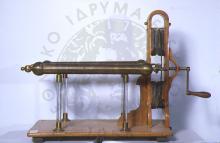It is an electrostatic machine which consists of a glass disc turned by a handle between two sets of leather cushions. The handle and the disc are supported by a wooden frame. The two big horizontal bronze tubes on glass supporters curve around the disc and collect the charge produced by the rotation of the disc, with a series of points. The charge is conducted to the other end of the tubes, where it is collected. The two sets of cushions are earthed through a wire.
Functioning:
The Ramsden machine produces electrical charge by friction. As the disc rotates between the leather cushions it is charged positively and the cushions negatively. The negative charge is conducted by the earthening wire, while the positive induces the appearance of a positive charge on the other end of the conductor tubes.
History:
This type of electrostatic machine was invented in 1766, by the english constractor J. Ramsden (1735-1800).

